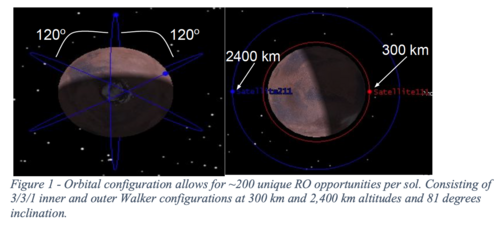A Mars Smallsat Radio Occultation Mission Concept for Addressing High-Priority Mars Science and Exploration
- 1The University of Michigan, Climate and Space Sciences and Engineering, United States of America (sweendav@umich.edu)
- 2Jet Propulsion Laboratory, California Institute of Technology, Pasadena, CA, USA
- 3Lunar and Planetary Institute, Universities Space Research Association, Houston, TX, USA
INTRODUCTION
Radio Occultation (RO) is a remote sensing technique that infers physical parameters of density, temperature, and pressure in the neutral atmosphere and electron density in the ionosphere based on the Doppler shift of radio signals [1]–[3]. It provides high vertical resolution and is insensitive to aerosols. RO can fill in a number of existing observational gaps gaps in the Martian atmosphere that have been emphasized by the science community [5].Traditionally, RO is accomplished via a link between the orbiting spacecraft and the Deep Space Network (DSN) [2]–[4]. However, the spacecraft-to-DSN link limits the viewing geometry and overall coverage. A dedicated fleet of Smallsats offers a low-cost solution to yield an unprecedented number of RO profiles to achieve high temporal and spatial coverage, which can significantly augment existing and future Mars missions. In particular, the constellation can support and augment atmospheric observations required in Entry, Descent and Landing (EDL) and Ascent from the Surface (AST) operations.
MISSION CONCEPT
Preliminary requirements for the mission identify a minimum number of 100 RO observations per day globally, temperature uncertainty of 1 K between 6-12 km altitude, and number density uncertainty in the ionosphere of 5%. The mission concept proposed utilizes a fleet of 6 smallsats in high inclination orbits to maximize the number of global observations per day. The ideal orbital configurations were simulated using the Systems ToolKit (STK). The configuration which allows for ~200 RO observations per day consists of inner (300 km) and outer (2,400 km) 3/3/1 Walker orbits at 87° inclination (Figure 1).
RO APPROACH AND EXPECTED PERFORMANCE
A dual frequency one way approach is implemented for the RO observations [3]. A relationship exists between refractivity, pressure, and temperature in the neutral atmosphere, radio frequency and electron number density in the ionosphere [4]. Using a linear combination of X and UHF bands, the ionosphere and neutral atmosphere components can be effectively separated. The vertical resolution is determined based on the orbital velocity data from STK. We simulated the link and retrieval performance considering the expected thermal noise of the communications system, and clock noise of the ultra-stable oscillator (USO) based on commercial off the shelf (COTS) parts. Converting bending angle profiles to refractivity and finally pressure and temperature, we find that USO performance with Allan deviations on the order of 10-13 s/s meet the requirements of 1 K temperate uncertainty between 6-12 km altitude above the surface and < 5% error in the ionosphere. Future work will consider an alternative approach to RO observations via a dual one-way method which employs only a single radio band transmitting and receiving at slight offset frequencies. This approach will allow for the implementation of a less stable USO without increasing the clock noise.

References: [1]D. P. Hinson et al. (2014) Icarus 243, doi: 10.1016/j.icarus.2014.09.019. [2] M. F. Vogt et al. (2016) J. Geophys. Res. Space Physics 121, , doi: 10.1002/2016JA022987. [3] P. Withers (200) Advances in Space Research 46(1) doi: 10.1016/j.asr.2010.03.004. [4]G. A. Hajj, E. R. Kursinski, L. J. Romans, W. I. Bertiger, and S. S. Leroy, (2002) Journal of Atmospheric and Solar-Terrestrial Physics 64 (4) , doi: 10.1016/S1364-6826(01)00114-6. [5] D. Banfield (2020) MEPAG Goals Document.
How to cite: Sweeney, D., Ao, C., Vergados, P., Rennó, N., Kass, D., and Martínez, G.: A Mars Smallsat Radio Occultation Mission Concept for Addressing High-Priority Mars Science and Exploration , European Planetary Science Congress 2021, online, 13–24 Sep 2021, EPSC2021-401, https://doi.org/10.5194/epsc2021-401, 2021.

